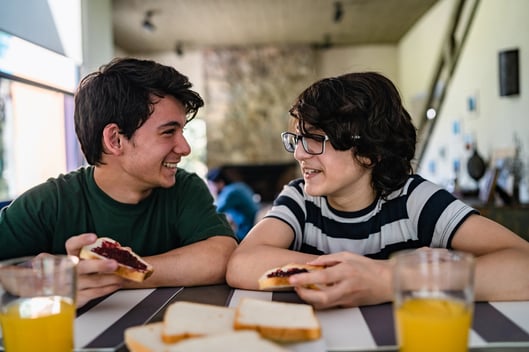Autism: It Does Get Better!
The Top 6 Interventions for Positive Progress
One question every exhausted and overwhelmed autism parent or teacher asks themselves or others at some point is, “Will this ever get better?” I wondered the same at times when my grandson was young and more than a handful. He was a runner, had numerous sensory challenges, melted down unexpectedly at home, at school, or in public, and the list goes on.
I didn’t know the answer then, but I do now: Yes, it does get better! All the interventions and therapies he received over the years have paid off, and there was proof of that once again recently.
When we went to his dentist appointment for a yearly check-up—or so I thought it was—it had been changed to a cleaning appointment, something he has been averse to for a long time. I flashed back to some of his earliest dental appointments and cleanings, and how difficult these were for him. For a moment I almost panicked and wondered how he would react to this sudden change without prior preparation. But I should not have worried.
After explaining it to him calmly and matter-of-factly, he said, “Okay!” He sat down in the chair and did not complain or groan once throughout the 45-minute procedure. The only comment he made was a polite request to the hygienist to please not touch his teeth with her Latex-gloved hand, as he didn’t like that sensation. She replied she’d do her best and the rest of the appointment went by without a hitch.
When saying goodbye, the hygienist and receptionist both commented that he made them smile with his enthusiastic banter about retro arcade games, his current special interest, before and after his time in the chair. My reply? He makes me smile every day!
And so does the realization that as challenging as autism can be, it does get better over time when we provide appropriate individual interventions for each unique autistic child as early as possible. Here are some of the things that helped my grandson that you can also try to help your child or student with autism thrive…
1. Be Mindful of Sensory Issues
Most, if not all autistic children present with sensory issues if not Sensory Processing Disorder (SPD). When autistic children run off, break down, or otherwise act out, the root cause of the behavior may very well be sensory-related.
When very young, my grandson would cry inconsolably each time I put on his socks and shoes and he kicked them off faster than I could put them on. When he was diagnosed as autistic with SPD it all made sense. His occupational therapist prescribed seamless socks, soft footwear, a brushing routine, and exercises that over time helped him become more sensory tolerant.
Other sensory issues can upset your autistic child too. Fluorescent lights and certain smells and sounds can make it difficult for them to concentrate. Soft lighting, using cool, calm colors in bedrooms and classrooms, and avoiding overstimulating décor on the walls both at home and at school can help create a calm and relaxing atmosphere. Some children may need a personal desk with a partition to shield them from distractions to help them focus in class, and noise-dampening headphones can help reduce distracting or upsetting loud sounds both indoors and outdoors.
Providing these supports early on, and slowly decreasing them over time, will build the autistic child’s sensory tolerance, and some of the challenging issues presented when young may no longer be a problem later.

2. Use Visual Supports
Most autistic children are visual learners. Visual supports serve as reminders of classroom rules, scheduled events, where things belong or can be found, and the list goes on. Using pictures and modeling expectations often goes a lot further than merely telling an autistic child what to do. As the child grows older, he may not want to use pictures anymore and graduate to written checklists or inconspicuous notes to remind them of what is expected of them. My grandson, now a teenager, always has been and always will be a visual learner. Having used visual supports throughout his life, he has learned to remind himself now with checklists on his phone. Practice makes perfect!
3. Maintain Routine as Much as Possible
The other day, while at a youth gathering, I met someone who also has an autistic grandson, who, she told me, does not like change and wants everything to be the same every day. My grandson overheard our conversation and interjected, “Oh, I am autistic too and I don’t like change either!”
I always had a visual schedule for my grandson, both at home and at school, which we diligently reviewed every morning over breakfast. His teachers tried to inform me as much as possible of any schedule changes ahead of time so I could prepare him, but if they couldn’t, such as a canceled recess because of inclement weather, the change in routine was a great opportunity for him to practice his coping skills to manage the unexpected turn of events.
Having predictability at home and in a classroom as much as possible eases anxiety for autistic children and will help them focus much better on the task at hand rather than worry about what will happen next. Providing a schedule of events that they can follow that includes a “surprise” icon, is a great way to ease anxiety and teach them how to handle sudden change appropriately.
4. Communicate with Simple Concrete Language
Autistic children are mostly literal and visual thinkers and have a hard time understanding figures of speech, which they will most likely translate into very concrete terms or concepts. Imagine what they may “picture” when you tell them, “It’s raining cats and dogs!” or “Don’t beat around the bush!” I have had my grandson burst out in laughter at sayings like this.
If you do use idioms, use the opportunity to teach figurative language and hidden meanings in certain and concrete terms. I purchased an Idiom Dictionary some years ago, which was my grandson’s favorite book for a while. He learned the meaning of many abstract sayings this way, but still regularly asks me to clarify the meaning of certain sayings he’s unfamiliar with that he may hear in conversation.

5. Teach Social Skills
Most children learn social skills by observing how other people and children around them conduct themselves. They see their parents greet others, and they will copy those greetings. Autistic children are not able to read this hidden curriculum, and things like greeting, saying goodbye, and engaging in simple back-and-forth conversations have to be taught directly. This is why it is important to teach and model appropriate social skills and discuss how our behavior can make others feel. There are some great resources available on socialthinking.com to help teach social skills to younger autistic children.
For my grandson, I wrote Friends Are…? when he was younger to teach him basic social skills. Now that he is older, he is much better at initiating conversation, but he still needs help in properly carrying on a conversation once he has met and greeted someone. The UCLA PEERS Program has excellent resources for teenagers and adolescents and a number of their videos are available on YouTube to visually show the correct ways to interact with peers. Watching these short video clips with my grandson has been a great way to teach him social expectations.
6. Always Be Kind
Of course, this goes without saying, but I am going to say it anyway! It is very important to always demonstrate kindness, patience, understanding, and respect. Each child is unique, and autism affects each individual differently. Celebrate each child’s successes, and don’t worry if some of these recommendations, while helpful to some, do not work as well for others. Adapt them where needed and positively reinforce the child’s efforts and accomplishments. A pat on the back for even the smallest bit of progress may be just the motivation they need to keep trying.

My grandson thrives on compliments, and every so often, when I may not have commended him for something he tried very hard to get right, he will ask me, “Grandma, are you proud of me?” And of course, I am!
These six simple and easy-to-implement interventions have made a world of difference in my grandson’s prognosis, and as I and others continue to work with him, I am sure we will continue to see him make positive progress as a result of all the hard work that went into teaching him.
The autism journey is challenging, but early intervention and consistent instruction will pay off, to where you too will be able to look back and say, “It did get better!”
What strategies and interventions have you used to help your autistic child or students, and what progress have you witnessed as a result? We’d love to hear about it in the comments.
We hope you enjoyed the information in this article. STAGES® Learning also offers free downloadable resources to support teaching and learning with autistic individuals. Start with our free Picture Noun Cards and see our collection of other downloadable resources here!

Ymkje Wideman-van der Laan
Ymkje Wideman-van der Laan is an author, public speaker, and Certified Autism Resource Specialist from the Netherlands. After working abroad as a teacher and humanitarian for 25 years, she moved to the US in 2006 and assumed the care of her then 6-month-old grandson, Logan. There were signs of autism at an early age, and the diagnosis became official in 2009. She has been his advocate and passionate about promoting autism awareness and acceptance ever since. Logan is the inspiration behind the Autism Is...? (tinyurl.com/5aj73ydd) series of children’s books she initially wrote for him and later published. Ymkje currently lives in California with her now 15-year-old grandson, and besides writing, presents autism training workshops for early childhood educators, parents, and caregivers. You can read more about her story in her newly released book, Autism on a Shoestring Budget, [Early] Intervention Made Easier (https://tinyurl.com/ysxhxbmf). For more information, you can visit www.autism-is.com, www.facebook.com/AutismIs, and/or contact her at autismisbooks@gmail.com.




